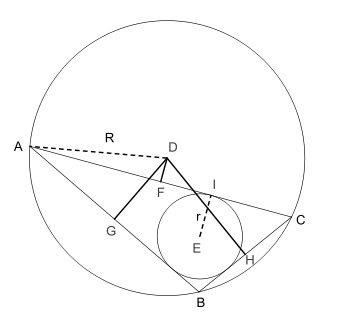Carnot's theorem

In Euclidean geometry, Carnot's theorem, named after Lazare Carnot (1753–1823), is as follows. Let ABC be an arbitrary triangle. Then the sum of the signed distances from the circumcenter D to the sides of triangle ABC is
DF + DG + DH = R + r,\ where r is the inradius and R is the circumradius. Here the sign of the distances is taken negative if and only if the line segment DX (X = F, G, H) lies completely outside the triangle. In the picture DF is negative and both DG and DH are positive.
No vote yet
1 vote
Easy Math Editor
This discussion board is a place to discuss our Daily Challenges and the math and science related to those challenges. Explanations are more than just a solution — they should explain the steps and thinking strategies that you used to obtain the solution. Comments should further the discussion of math and science.
When posting on Brilliant:
*italics*or_italics_**bold**or__bold__paragraph 1
paragraph 2
[example link](https://brilliant.org)> This is a quote# I indented these lines # 4 spaces, and now they show # up as a code block. print "hello world"\(...\)or\[...\]to ensure proper formatting.2 \times 32^{34}a_{i-1}\frac{2}{3}\sqrt{2}\sum_{i=1}^3\sin \theta\boxed{123}Comments
There are no comments in this discussion.